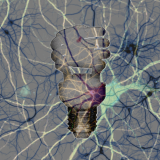Near and Far in Idea Space
One of the useful things about placing ideas in a spatial system is that you can talk about differentiation – the degree of difference between ideas, concepts, models, etc. – in a clear and explicit way. The generative metaphor (“ideas are born”) or constructive metaphor (“ideas are made”) do not lend themselves as well to this kind of discussion. To use our apple example, we can find a Red Delicious and a Golden Delicious apple pretty close to one other, in a space defined as “all apples”, just a step away along the color dimension. Granny Smith apples are farther away … different color AND different taste / texture (much more tart, crisp, etc.) If we widen the idea space to include “fruits that grow on trees”, then we can find examples that are even more distant … pears, for example, are characterized by a different shape, taste, name, species, etc. Even farther down the road is the proverbial “different than an apple” fruit, the orange. By placing concepts on a spatial grid, we can discuss “how different” an idea is, by talking about how close or far away it is, even though the distance is purely abstract. I’ve found that it’s possible to get a roomful of people to discuss difference in spatial terms, and achieve consensus about how near and far different ideas are from each other. In the process of brainstorming, this spatial analogue for “how different?” can be enormously useful. We can map an idea on the board, and say we’re looking for something close to that idea, or something really far away, and people will know what we’re talking about. We can talk about the direction of difference, and regroup ideas by different dimensions, as a way of exploring common characteristics. Being explicit about the metaphors we use helps us employ them more deeply and widely, conscious of the tools we’re using to...
read moreTalking About Ideas
How we use ideas is shaped by how we talk about them, the exact words we use. So how do we communicate about the nature of ideas, which are notoriously abstract? With metaphors. whereideascomefrom is a site about metaphors about ideas. Why is this important? Because ideas are at the core of what makes us human, just as words are. And the complex interaction of words and ideas is critical to how we work, create, and innovate.
read moreIdeas Are Born
The most common metaphors we apply to idea creation are what I call “generative” metaphors. An idea arose; we came up with it; it popped out of my head; it grew on me. We planted the seeds of it. It sprouted, it hatched. An idea is born, it comes of age, grows old and dies. “We sat around the whiteboard and generated a bunch of ideas.” It seems clear that these are biological in essence, either botanical or zoological, or at least mytho-biological, like Athena being born from the head of Zeus. In this metaphorical universe, an idea starts as a seed or egg. It has a kind of DNA, by which it can be related to other ideas, and by which it can be traced back to its creator and beyond to earlier progenitive ideas. It has kinship with other ideas, it is part of a family. It can mutate, evolve, give birth to other ideas. Creativity as a concept is closely associated with this universe. The image of “creating” ideas could be theoretically be constructive or manipulative (about building or shaping) but is more often biological – planting, growing, procreating, incubating, fertilizing. One of the strengths of the generative metaphor is that it seems to relate to some of the unconscious processes by which ideas appear in our minds. Associative thinking, for example, calls to mind all sorts of reproductive metaphors of meiosis and cross-fertilization. Because it is so ubiquitous, the generative metaphor in particular should be examined for potentially misleading, confusing or limiting implications. Here are a few … An idea has a certain organic integrity, separateness, a boundary, almost like a cell membrane. Changing a small aspect implies surgery, mutation, evolution. You need to be in a special state of some kind in order to generate new ideas. You need to be creative or feel creative; this is a mysterious condition, which some people experience more than others. My idea is my idea, because it has my DNA. There is a proprietary link; I am its “creator”. Changing “my” idea, or “stealing” it, implies a certain amount of pain....
read moreIdeas Are Made
Last in the list of three categories of metaphors central to ideation is the “constructive” metaphor. It’s not quite as common in conversation as generative or spatial, but in many ways it’s equally important. We build on other people’s ideas, we plug one idea into another, an idea is fundamental. We work on an idea, we shape it, we tinker with it, we tear it down, we deconstruct it. I also tend to throw into this category the occasional metaphor which treats ideas as something chemical: we cook up an idea, we throw it into the mix, we refine it, we distill it down. All of these usages imply that the idea is something that is material and “made”, created consciously or affected directly by human tools and processes. One reason this category is important is because it’s an accurate representation of how ideas are manipulated at certain stages in an innovation process. Whether the original “source” of an idea is generative or spatial, at some point we grab it and start working with it consciously. At that point, it starts to become a different idea, often more complex, with more components and layers. So it’s helpful to understand that something different is also happening from a conceptual point of view. In the transition from generative to constructive, for example, the original sense of ownership may become fuzzy or lost. The idea (which at this point is an assembly of different ideas) may seem less original and organic. In the transition from spatial to constructive, we may lose a clear sense of where the idea is in relationship to similar ideas … it can be harder to see the possible variations in the key dimensions of the idea, and so the original choices become “set in stone”. Nevertheless, it’s a necessary transition. We need to work on ideas to make them useful. Simple ideas need to get more complex as they move to implementation. Being conscious that we’ve shifted to a constructive metaphor is tremendously useful in managing the...
read more(Brain)Storming
Brainstorming represents the relatively rare weather metaphor in ideation. And yet it captures some very important underlying realities. It suggests the chaotic, even random, experience of ideation, particularly in early stages, and the sense that a lot of energy (both heat and light) is invested and/or produced. This image may be truer to the underlying processes of associative thinking than some of the more organic or intentional metaphors.
read more




